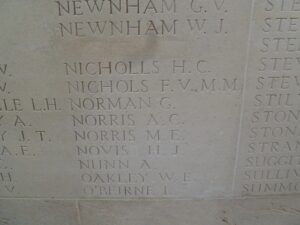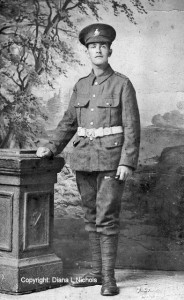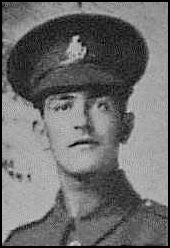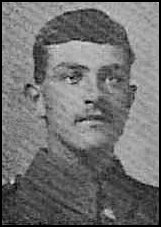Category: Military
Rank: Private G/124
Regiment or Ship: 7th Service Bn Royal Sussex Regiment
Service Number(s): G/124
Occupation: Porter
Date of Birth: 19.06.1897
Place of Birth: Kensington London
Date of Death: 04.08.1916
Place of Death: Pozieres, France
Place of Burial / Memorials:
 Thiepval Memorial Pier and Face 7C, Bexhill War Memorial and St Mary Magdalene War Memorial
Thiepval Memorial Pier and Face 7C, Bexhill War Memorial and St Mary Magdalene War Memorial
Address: St James Road, Bexhill
Photos and newspaper articles
Family Information
Father: John 1856-1925
Mother: Alma 1861-1929
Siblings:
Charles Arthur Hawkins 1884-1971
Emma Mary Nichols 1886-1970
John Albert Nichols 1889-1962 W0097 NICHOLS John (Driver)
Annie E Nichols 1891-1918
Robert Henry Nichols 1894-1932
Florence Alma Nichols 1899-1918
Brother of sister in law: Edwin Charles Waite W0122 WAITE Edwin Charles (Private)
Brother of sister in law: Eldred Waite W0123 WAITE Eldred (Private)
Brother in law: Charles Henry Britt W0073 BRITT Charles (Driver)
Brother in law: Nelson James Britt W0074 BRITT Nelson James (Ordinary Seaman)
Brother in law: George Edward Veness W0119 VENESS George (Driver)
First World War Experience
In August 1914, Frank was staying with his elder brother Jack and his family at 14 North Road, Sidley. He was 17 in June 1914 and volunteers had to be at least 19. Frank reported to Bexhill Town Hall and enlisted into the Royal Sussex Regiment to serve for 3 years. On the Attestation Form he declared himself to be 19 years and one month, adding two years to his actual age. The Army did not demand sight of his birth certificate and the Medical Officer stated that his ’apparent age’ was 18 years and 1 month – still a year under the stated minimum age.
Frank was given his full Medical Examination at the Royal Sussex Regiment’s barracks in Chichester on 14th August, two days after he enlisted. He was posted to General Service with the Royal Sussex with the number G/124 on 19th August, and on 29th August 1914 was posted as a Private to the 7th Battalion of the Regiment. This battalion had only been raised 10 days before as part of the first of Kitchener’s new armies.
The Battalion joined 36th Brigade, 12th Division, Sabraon Barracks, Colchester. In October 1914 the Battalion moved to Shorncliffe, then two months later to billets in Folkestone. In March 1915 it moved to Ramilies Barracks, Aldershot, for final training where it remained until 30th May 1915.
He landed at Boulogne with his unit on 1st June. After initial tuition Frank occupied his first trench near Armentieres. He remained in that vicinity until the end of September during which he had a stay in hospital.
In early 1916 the 7th battalion was in the Hohenzollern Redoubt and experienced the stiffest fighting they had come across. Following the explosion of four huge mines there was a great deal of severe crater fighting. Some ground was gained by the Battalion but this caused very strong counter-attacks, the barrages being particularly heavy. The Germans were repulsed on each occasion, and despite heavy casualties the Battalion held fast to the ground gained, for which they were awarded a special Commendation by the Corps Commander. As April drew to a close, the 7th Battalion was in support close up to the front. They were very heavily shelled and came in for a very strong cloud of gas, the result of an attack made on the first line. The gas was as thick as a London fog and the battalion had to wear gas masks for 30 minutes. No casualties were sustained.
In June 1916 the 7th Battalion moved into the neighbourhood of Amiens and the first Battle of the Somme was imminent. Frank was in ‘B’ Company. The Battalion fought in the Battle of Albert 1 – 13 July 1916. On the 7th and 8th July 1916, the Battalion participated in the capture of Ovillers la Boiselle. It was a very hard fight and they achieved their objective after two failures by other troops during the previous week.
Frank was awarded the Military Medal for his bravery during the capture of Ovillers la Boiselle, it was not officially mentioned until 29th August in the War Diary covering the Pozieres honours. The award was made on 19th September, 1916. Frank had been dead over a month.
War Diary 7th Battalion Royal Sussex Regiment August 1st to 4th 1916
1st Fairly heavy shelling of communication and support trenches during day and night.
2nd Usual shelling day and night.
3rd 8th Royal Fusiliers attacked RATION trench at 9 pm after artillery preparation and captured most of it.
4th At 3am received orders to send one Company over to RATION trench to get in touch with 8th Royal Fusiliers and work up to the right; also one Platoon to attack strong point on the right, after this had been captured they were to work down RATION and get in touch with A Company.
A Company went too much to the left, but reached RATION trench finding the Buffs already there. Col. Cope (O.C. Buffs) ordered A Coy. To push forward and take the ridge, which they reached without any difficulty; but were heavily counter attacked and obliged to fall back to RATION trench. The Platoon on the right came under heavy Machine Gun fire and were not able to capture the strong point. Later in the day orders were received for two Companies to attack the right of RATION trench in conjunction with attack of 9th Royal Fusiliers.
Two Platoons were again to attack Strong point on right from POZIERS trench. B [Frank’s Company] and D Companies attacked across the open but lost direction, some however reached their objective and got in touch with the 9th Royal Fusiliers. The two Platoons of C Company were unable to capture Strong point, owing to heavy Machine Gun fire. The result of this operation was that practically the whole of RATION trench was captured and consolidated.
Casualties during two days. 2nd Lieuts. Wood Le Doux Veitch, Killed. 2nd Lieuts Cooke, Fitzsimmons, Rolfe, Missing. Capt Trower, 2nd Lieuts. D Alton, Glenister, Howe, Browning, Wounded. Other Ranks 18 killed, 25 missing, 109 wounded.
War Diary 7th Battalion Royal Sussex Regiment 29th August 1916
Parades under Coy. Arrangements. A Coy at range in morning. Concert for the men in Y.M.C.A. Hut from 5 TO 7 P.M. Very heavy rain most of the day. The II Corps Commander awarded the Military Medal to the following W.O.s N.C.O.s and men for
POZIERS operations:- A/C.S.M. Richold, Sergt Rovery, A/Sergt Lawrence, L/Cpl Mayes, Pte Glenister, Pte Newport, Pte Nicholls, Pte Goddard, Pte Aungier, Pte Selsby, Pte White.
In 1926, there was some correspondence between the Army and his mother’s representative, a Mr H. A. Bull, concerning Frank’s medals. His mother clearly believed that Frank had been awarded the Distinguished Conduct Medal, and she had not received the medal or the £20 gratuity. The Infantry Record Office, Hounslow, stated that their records showed no trace of the DCM being awarded to Frank. The Colonel In Charge Infantry Records went on to state ‘The medals earned by this man are the Military Medal, 1914-15 Star, British War and Victory Medals all of which have been issued’. This confusion over the DCM was probably caused in Bexhill. The Bexhill War Memorial shows Frank Victor Nichols as MM, and DCM. Whether the engravers got confused or Frank’s Bexhill family became over-enthusiastic about Frank’s medals is not known. However, it is possible that either Frank’s mother or one of his other siblings visited Bexhill to see Frank’s name on the Bexhill War Memorial. Once Alma knew of the DCM, she thought that it had not been issued.




